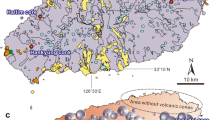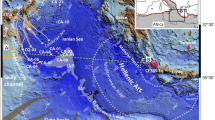Abstract
The eruption of Toba (75,000 years BP), Sumatra, is the largest magnitude eruption documented from the Quaternary. The eruption produced the largest-known caldera the dimensions of which are 100 × 30 km and which is surrounded by rhyolitic ignimbrite covering an area of over 20,000 km2. The associated deep-sea tephra layer is found in piston cores in the north-eastern Indian Ocean covering a minimum area of 5 × 106 km2. We have investigated the thickness, grain size and texture of the Toba deep-sea tephra layer in order to demonstrate the use of deep-sea tephra layers as a volcanological tool. The exceptional magnitude and intensity of the Toba eruption is demonstrated by comparison of these data with the deep-sea tephra layers associated with the eruptions of the Campanian ignimbrite, Italy and of Santorini, Greece in Minoan time. The volume of ignimbrite and distal tephra fall deposit produced in the Toba eruption are comparable, a total of at least 1000 km3 of dense rhyolitic magma. In contrast the volume of dense magma produced by the Campanian and Santorini eruptions are approximately 70 and 13 km3 respectively. Thickness versus distance data on the three deep-sea tephra layers show that eruptions of smaller magnitude than Santorini are unlikely to be preserved as distinct tephra layers in most deep-sea cores. In proximal cores all three tephra layers show two distinct units: a lower coarse-grained unit and an upper fine-grained unit. We interpret the lower unit as a plinian deposit and the upper unit as a co-ignimbrite ash-fall deposit, indicating two major eruptive phases. The Toba tephra layer is coarser both in maximum and median grain size than the Campanian and Santorini layers at a given distance from source. These data are interpreted to indicate a very high cruption column, estimated to be at least 45 km. We have applied a method for estimating the duration of the Toba eruption from the style of graded-bedding in deep-sea tephra layers. Studies of two cores yield estimates of 9 and 14 days. The eruption column height and duration estimates both indicate an average volume discharge rate of approximately 106 m3/sec. The Toba eruption therefore was not only of exceptional magnitude, but also of exceptional intensity.
Similar content being viewed by others
References
Aramaki, S. andUt, T., 1966,The Aira and Ata Pyroclastic Flows and Related Caldera Depressions in Southern Kyushu, Japan. Bull. Volcanol.,29, p. 29–47.
Bailey, R. A., Dalrymple, G. B. andLamphere, M. A.,Volcanism, Structure, and Geochronology of Long Valley Caldera, Mono County, California. J. Geophys. Res.,81, p. 725–744.
Barberi, F., Innocenti, F., Lirer, L., Munno, R., Pescatore, T. andSantacroce, R., 1978,The Campanian Ignimbrite: a Major Prehistoric Eruption in the Naples Area (Italy). Bull. Volcanol.,41–1, p. 10–31.
Bemmelen, R. W. van, 1939,The Volcanotectonic Origin of Lake Toba (North Sunatra). De Ing. in Ned. Ind.,6, p. 126–140.
—————, 1949,The Geology of Indonesia. 1, Martinus Nijhoff, The Hague, 732 pp.
Bond, A. andSparks, R. S. J., 1976,The Minoan Eruption of Santorini, Greece. J. Geol. Soc. Lond.,132, p. 1–16.
Borch, C. C. von der,et al., 1974,Site Reports. Initial Reports of the Deep Sea Drilling Project. Government Printing Office, Washington D.C.,22, p. 3–349.
Collings, H. D., 1938,Pleistocene Site in the Malay Peninsula. Nature,142, p. 575–576.
Curray, J. R. andMoore, D. G., 1971,Growth of the Bengal Deep-sea Fan and Denudation of the Himalayas. Geol. Soc. Amer. Bull.,82, p. 563–572.
Fisher, R. V., 1964,Maximum Size, Median Diameter and Sorting of Tephra. J. Geophys. Res.,69, p. 341–355.
Hahn, G. A., Rose, W. I., Jr. andMeyer, T., 1978,Geochemical Correlation of Genetically Related Rhyolite Ash-flow and Airfall Ashes, Central and Western Guatemala and Equatorial Pacific. Geol. Soc. Amer. Special Paper on Ash-Flow Tuff (in press).
Huang, T. C., Watkins, N. D. andWilson, L., in press,Deep-sea Tephra: Azores Volcanism in the Last 300,000 Years. Geol. Soc. Amer. Bull.
Inman, D. L., 1952,Measures for Describing the Size Distribution of Sediments. J. Sedim. Petrol.,22, p. 125–145.
Katsui, Y., 1961,Evolution and Magmatic History of Some Krakaotan Calderas in Hokkaido, Japan. J. Fac. Sci. Hokkaido Univ.,IV, 11, p. 631–650.
Keller, J., Ryan, W. B. F., Ninkovich, D. andAltherr, R., 1978,Explosive Volcanic Activity in the Mediterranean over the Past 200,000 Years as Recorded in Deep-sea Sediments. Geol. Soc. Amer.,89, p. 591–604.
Knox, J. B. andShort, N. M., 1964,A Diagnostic Model Using Ash-fall Data To Determine Eruption Characteristics and Atmospheric Conditions during a Major Volcanic Event. Bull. Volcanol.,27, p. 5–24.
Ledbetter, M. andSparks, R. S. J., 1979,The Duration of Large-magnitude Silicic Eruptions Deduced from Graded Bedding in Deep-sea Tephra Layers, Geology,7, p. 240–244.
Lipman, P.W., Prostka, H. J. andChristiansen, R. L., 1972,Cenozoic Volcanism and Plate-tectonic Evolution of the Western United States, Parts I and II. Phil. Trans. R. Soc. Lond.,A-271, p. 217–248.
Machida, M. andArai, F., 1976,A Widespread Volcanic Ash Discovery of Aim-Ta Ash and Its Significance. Kagaku,46, p. 339–347.
Ninkovich, D., 1968,Pleistocene Volcanic Eruptions in New Zealand Recorded in Deep-sea Sediments. Earth and Planet. Sci. Letts.,4, p. 89–102.
—————, 1979,Distribution, Age and Chemical Composition of Tephra Layers in Deep-sea Sediments off Western Indonesia. J. Volcanol. and Geothermal Res.,5, p. 67–86.
————— andDonn, W. L., 1976,Explosive Cenozoic Volcanism and Climatic Implications. Science,194, p. 899–906.
----- andHeezen, B. C., 1965,Santorini Tephra. Proc. 17th Symp. of the Colston Research Society, University of Bristol,XVII, p. 413–452.
————— and —————, 1967,Physical and Chemical Properties of Volcanic Glass Shards from Pozzuolana Ash, Thera Island, and from Upper and Lower Ash Layers in Eastern Mediterranean Deep-sea Sediments. Nature,213, p. 582–584.
----- andRuddiman, W., 1977,Bioturbation of Volcanic Ash Layers in Deep-sea Sediments. X INQUA Congress Proc. (abstract), p. 326.
————— andShackleton, N. J., 1975,Distribution, Stratigraphic Position and Age of Ash Layer « L » in the Panama Basin Region. Earth and Planet. Sci. Letts.,27, p. 20–34.
—————, —————,Abdel-Monem, A. A., Obradovich, J. D. andIzett, G., 1978,K-Ar Age of the Late Pleistocene Eruption of Toba (North Sumatra).Nature, 276, p. 574–577.
Settle, M., 1978,Volcanic Eruption Clouds and the Thermal Power Output of Explosive Eruptions. J. Volcanol. and Geothermal Res.,3, p. 1727–1739.
Shaw, D., Watkins, N. D. andHuang, T. C., 1974,Atmospherically Transported Volcanic Glass in Deep-sea Sediments: Theoretical Considerations. J. Geophys. Res.,79, p. 3087–3094.
Smith, R. L., 1960,Ash-flows. Geol. Soc. Amer. Bull.,71, p. 795–842.
Sparks, R. S. J., Self, S. andWalker, G. P. L., 1973,The Products of Ignimbrite Eruptions. Geology,1, p. 115–118.
————— andWalker, G. P. L., 1977,The Significance of Vitric-enriched Air-fall Ashes Associated with Cristal-enriched Ignimbrites. Jour. Volcanol. and Geothermal Res.,2, p. 329–341.
————— andHulme, G., 1978,Theoretical Modeling of the Generation, Movement, and Emplacement of Pyroclastic Flows by Column Collapse, J. Geophys. Res.,83, p. 1727–1739.
Susuki, T., Katsui, Y. andNakamura, T., 1973,Size Distribution of the Tarumai Ta-Tb Pumice Fall Deposit. Bull. Volc. Soc. Japan,18, p. 47–63.
Thorarinsson, S., 1954,The Tephra Fall from Hekla on March 29 th, 1947. In:The Eruption of Hekla 1947–48. II, p. 1–78, Leiftur, H.F., Reykjavik.
Tjia, H. D. andKusnaeny, K., 1976,An Early Quaternary Age of an Ignimbrite Layer, Lake Toba, Sumatra. Sains Malaysiana,5, p. 65–70.
Tsuya, H., 1955,Geological and Petrological Studies of Volcano Fujii, 5: On the 1707 Eruption of Volcano Fujii. Bull. Earthquake Res. Inst.,33, p. 341–383.
Thunnel, R., Federman, A., Sparks, R. S. J. andWilliams, D. F., 1979,The Age, Origin and Volcanological Significance of the Y-5 Ash Layer in the Mediterranean. Quaternary Research,12, p. 241–253.
Walker, G. P. L., 1971,Grain-size Characteristics of Pyroclastic Deposits, Jour. Geology,79, p. 696–714.
—————, 1973,Explosive Volcanic Eruptions: A New Classification Scheme. Geol. Rundschau,62, p. 431–446.
Watkins, N. D., Sparks, R. S. J., Sigurdsson, H., Huang, T. C., Federman, A., Carey, S. andNinkovich, D., 1978,Volume and Extent of the Minoan Tephra from Santorini Volcano: New Evidence from Deep-sea Sediment Cores. Nature,271, p. 122–126.
Westerveld, J., 1952,Quaternary Volcanism on Sumatra. Geol. Soc. Amer. Bull.,63, p. 561.
Williams, H. andGoles, G., 1968,Volume of the Mazama Ash-fall and the Origin of Crater Lake Caldera. Oregon Dept. of Geology and Industry Bulletin,62, p. 37–41.
Wilson, L., Sparks, R. S. J., Huang, T. C. andWatkins, N. D., 1978,The Control of Volcanic Column Heights by Eruption Energetics and Dynamics. J. Geophys. Res.,83, p. 1829–1836.
Author information
Authors and Affiliations
Additional information
Lamont-Doherty Geological Observatory Contribution No. 2912.
Rights and permissions
About this article
Cite this article
Ninkovich, D., Sparks, R.S.J. & Ledbetter, M.T. The exceptional magnitude and intensity of the Toba eruption, sumatra: An example of the use of deep-sea tephra layers as a geological tool. Bull Volcanol 41, 286–298 (1978). https://doi.org/10.1007/BF02597228
Received:
Revised:
Accepted:
Issue Date:
DOI: https://doi.org/10.1007/BF02597228




